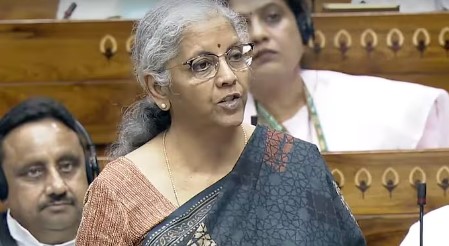Finance Minister Nirmala Sitharaman is set to unveil her seventh consecutive Budget on Tuesday, outlining a vision for a Viksit Bharat (developed India) by 2047 while reflecting on the past decade’s performance.
The spotlight will be on whether Sitharaman introduces the anticipated tax relief for the middle class, potentially increasing their disposable income amid favourable tax conditions. Additionally, markets will be watching for adherence to the fiscal glide path, targeting a fiscal deficit reduction to 4.5 per cent of GDP by 2025-26.
In her first Budget in 2019, Sitharaman replaced the traditional leather briefcase with a ‘bahi-khata’ wrapped in red cloth for carrying Budget documents. This year’s Budget, continuing the trend of the past three years, will be presented in a paperless format.
Here are the key numbers to monitor in the first full Budget of Modi 3.0:
Fiscal Deficit: The fiscal deficit for the current year is projected at 5.1per cent, an improvement from the previous year’s 5.8 per cent as per the Interim Budget. The full Budget is expected to show even better figures due to strong tax revenue performance. The government aims to achieve a fiscal deficit of 4.5per cent of GDP by FY26.
Capital Expenditure: The planned capital expenditure for this fiscal year is set at ₹11.1 lakh crore, up from ₹9.5 lakh crore in the previous fiscal year. The government is focusing on infrastructure development and incentivising States to increase capital expenditure.
Tax Revenue: The Interim Budget estimated gross tax revenue for 2024-25 at ₹38.31 lakh crore, marking an 11.46 per cent increase from the last fiscal year. This includes ₹21.99 lakh crore from direct taxes (personal income and corporate taxes) and ₹16.22 lakh crore from indirect taxes (customs, excise duty, and GST).
GST: Goods and Services Tax (GST) collections for 2024-25 are projected to reach ₹10.68 lakh crore, reflecting an 11.6 per cent rise. The final Budget will provide more details on this figure.
Borrowing: The gross borrowing budget for the current financial year was ₹14.13 lakh crore, according to the Interim Budget. This borrowing is crucial for financing the fiscal deficit. Market attention will be on this figure, particularly in light of higher-than-expected dividends from the RBI and other financial institutions.
Nominal GDP: Bharat’s nominal GDP growth for the current fiscal year is estimated at 10.5 per cent to ₹327.7 trillion. With anticipated improvements in revenue collections and rural consumption, there might be an upward revision of this growth estimate. Real GDP growth is projected at 7.2 per cent, as per the RBI.
Dividend: The Interim Budget projected ₹1.02 lakh crore from the RBI and financial institutions. This is expected to be revised upwards, following the RBI’s surplus transfer of ₹2.11 lakh crore in May. Additionally, ₹43,000 crore is anticipated from CPSEs.
Key Schemes and Sectors: Attention will also be on spending for important schemes like NREGA and key sectors such as health and education.

















